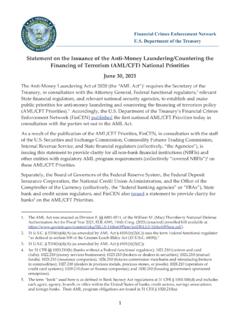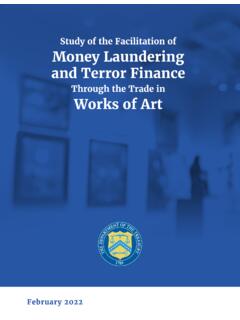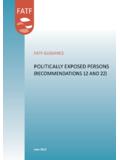Transcription of GUIDANCE FOR A RISK-BASED APPROACH
1 GUIDANCE FOR A RISK-BASED APPROACH . securities SECTOR. OCTOBER 2018. The Financial Action Task Force (FATF) is an independent inter-governmental body that develops and promotes policies to protect the global financial system against money laundering, terrorist financing and the financing of proliferation of weapons of mass destruction. The FATF Recommendations are recognised as the global anti-money laundering (AML) and counter-terrorist financing (CFT) standard. For more information about the FATF, please visit This document and/or any map included herein are without prejudice to the status of or sovereignty over any territory, to the delimitation of international frontiers and boundaries and to the name of any territory, city or area.
2 Citing reference: FATF (2018), GUIDANCE for a RISK-BASED APPROACH for the securities Sector, FATF, Paris, 2018 FATF/OECD. All rights reserved. No reproduction or translation of this publication may be made without prior written permission. Applications for such permission, for all or part of this publication, should be made to the FATF Secretariat, 2 rue Andr Pascal 75775 Paris Cedex 16, France (fax: +33 1 44 30 61 37 or e-mail: Photocredits coverphoto Thinkstock GUIDANCE FOR A RISK-BASED APPROACH FOR THE securities SECTOR 1. Table of contents ACRONYMS .. 3. RISK-BASED APPROACH GUIDANCE FOR THE securities SECTOR.)
3 4. Executive summary .. 4. INTRODUCTION AND KEY CONCEPTS .. 6. Background and context .. 6. Purpose of this GUIDANCE .. 7. Target audience, status and content of the GUIDANCE .. 7. Scope of the GUIDANCE : terminology, key characteristics and business models .. 8. International provision of securities products and services .. 14. SECTION I THE FATF'S RISK-BASED APPROACH TO AML/CFT (RBA) .. 15. WHAT IS THE RBA? .. 15. THE RATIONALE FOR A NEW APPROACH .. 15. APPLICATION OF THE RISK-BASED APPROACH .. 16. CHALLENGES .. 17. Allocating responsibility under a RBA .. 17. SECTION II GUIDANCE FOR securities PROVIDERS AND INTERMEDIARIES.
4 20. RISK ASSESSMENT .. 20. Country/Geographic 22. Customer/Investor risk .. 22. Product/Service/Transactions risk .. 23. Distribution channel risk .. 24. RISK MITIGATION .. 25. Customer/Investor due diligence .. 26. Electronic wire transfers requirements .. 33. Suspicious transaction monitoring and 34. INTERNAL CONTROLS AND COMPLIANCE .. 36. Internal controls and governance .. 36. Compliance controls .. 38. Vetting and recruitment .. 39. Training and awareness .. 40. SECTION III GUIDANCE FOR SUPERVISORS .. 41. THE RISK-BASED APPROACH TO 41. 2018 | FATF. 2 GUIDANCE FOR A RISK-BASED APPROACH FOR THE securities SECTOR.
5 Understanding ML/TF risk .. 41. Mitigating ML/TF risk .. 42. AML/CFT supervision of securities providers in a cross-border context .. 44. SUPERVISION OF THE RISK-BASED APPROACH .. 45. General APPROACH .. 45. 46. GUIDANCE and Feedback .. 46. ANNEX A. EXAMPLES OF COUNTRIES' SUPERVISORY PRACTICES FOR THE. IMPLEMENTATION OF THE RBA IN THE securities SECTOR .. 48. ANNEX B. SUSPICIOUS ACTIVITY INDICATORS IN RELATION TO securities .. 54. 2018 | FATF. GUIDANCE FOR A RISK-BASED APPROACH FOR THE securities SECTOR 3. ACRONYMS. AML/CFT Anti-money laundering/Countering the financing of terrorism CDD Customer 1 due diligence FIU Financial intelligence unit INR.
6 Interpretive Note to Recommendation IOSCO International Organisation of securities Commissions ML Money laundering PEP Politically- exposed person R. Recommendation RBA RISK-BASED APPROACH STR Suspicious transaction report TF Terrorist financing United Nations UN. 1. The industry often uses the term client which has the same meaning as customer for the purposes of this document. 2018 | FATF. 4 GUIDANCE FOR A RISK-BASED APPROACH FOR THE securities SECTOR. RISK-BASED APPROACH GUIDANCE FOR THE securities . SECTOR. Executive summary 1. The RISK-BASED APPROACH (RBA) is central to the effective implementation of the FATF Recommendations.
7 It means that supervisors, financial institutions, and intermediaries identify, assess, and understand the money laundering and terrorist financing (ML/TF) risks to which they are exposed, and implement the most appropriate mitigation measures. This APPROACH enables them to focus their resources where the risks are higher. 2. The FATF RBA GUIDANCE aims to support the implementation of the RBA, taking into account national ML/TF risk assessments and AML/CFT legal and regulatory frameworks. It includes a general presentation of the RBA and provides specific GUIDANCE for securities providers and for their supervisors.
8 The GUIDANCE was developed in partnership with the private sector, to make sure it reflects expertise and good practices from within the industry. 3. The GUIDANCE describes various types of securities providers that may be involved in a securities transaction and their business models. It also sets out key characteristics of securities transactions that can create opportunities for criminals, and measures that can be put in place to address such vulnerabilities. 4. The development of the ML/TF risk assessment is a key starting point for the application of the RBA by securities service providers. It should be commensurate with the nature, size and complexity of the business.
9 The most commonly used risk criteria are country or geographic risk, customer risk, product or service risk and intermediary risk. The GUIDANCE provides examples of risk factors under these risk categories. 5. The GUIDANCE highlights that it is the responsibility of the senior management of securities providers to foster and promote a culture of compliance as a core business value. They should ensure that securities providers are committed to manage ML/TF risks before establishing or maintaining business relationships. 6. The GUIDANCE clarifies the role and responsibilities of intermediaries that may provide services on behalf of securities providers to customers of securities providers, customers of intermediaries or both.
10 It highlights that the nature of the business relationship between the securities provider, the intermediary and any underlying customers will affect how ML/TF risks should be managed. This includes clarifying when the FATF's Recommendations on reliance apply. 7. The GUIDANCE clarifies that when determining the type and extent of CDD to apply, securities providers should understand whether its customer is acting on its own behalf or as an intermediary on behalf of its underlying customers. Even when CDD is the responsibility of the intermediary, an understanding of the intermediary's customer base can often be a useful element in determining the risk associated with the intermediary itself.












